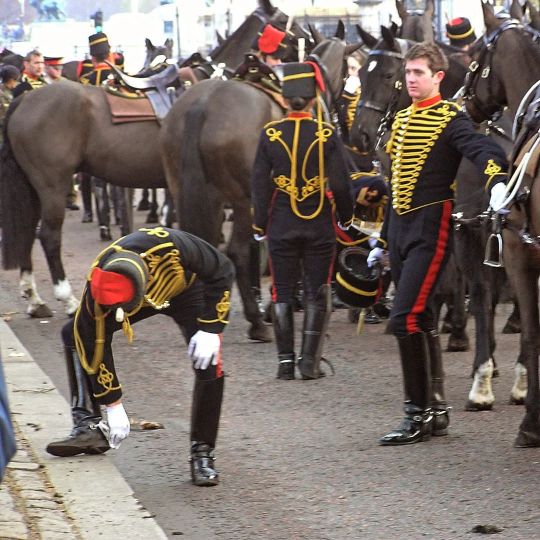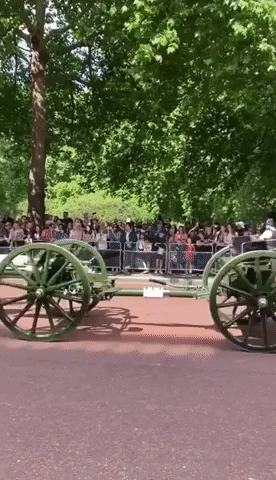#The King's Troop Royal Horse Artillery
Text
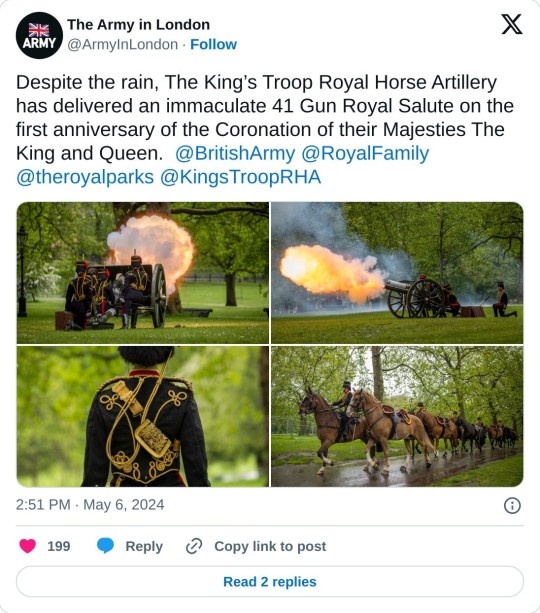

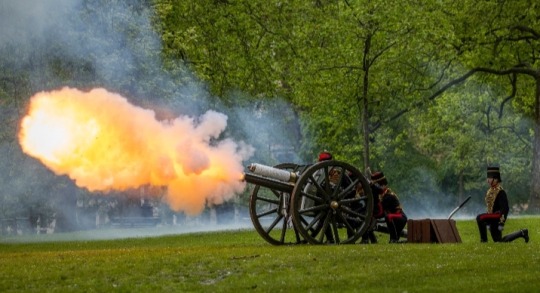


#King Charles III#His Majesty The King#British Royal Family#Coronation 2023#British Army#coronation#ceremony#tradition#history#Queen Camilla#41 Gun Royal Salute#The King's Troop Royal Horse Artillery#coronation anniversary
24 notes
·
View notes
Photo

Si post fata venit gloria, non propero.**
- Martial
The origins of the King’s Troop, Royal Horse Artillery can be traced back to the formation of the Royal Horse Artillery in 1793 when Captain Quist (a graduate of the Spanish Riding School of Vienna) was tasked with training both horses and gunners to support the Royal Artillery Regiment. Captain Quist clearly loved his job and continued in his post until his death in 1821, aged 91.
Between the First and Second World Wars, all the horses were sold when, in line with the entire British Army, the Horse Artillery was mechanised. But following the Second World War, at the request of King George VI, a saluting battery ‘dressed and equipped in traditional style’ was formed under the command of Lt Col Gillson. This would be the King’s Troop. Their first salute was fired in celebration of the King’s birthday on 24 October 1947 and following his inspection of his newly-formed riding troop, the King announced that he wished it to be known as the King’s Troop, a wish graciously supported and continued by his daughter when she became Queen, in recognition of her father’s special interest in the Troop.
Today the Troop’s duties include the firing of Royal Salutes on Royal anniversaries and State occasions, participation in Armistice Day parades, the Lord Mayor’s Show and the King’s birthday parade. As part of the Household Troops, the Troop also performs the duties of the King’s’s Life Guard at Horse Guards for one month each year. Perhaps the most famous of the Troop’s duties is the provision of the gun carriage and team of black horses for State and Military funerals.
Of the 154 soldiers in the unit, very nearly half are female, an unusually high percentage for the British Army since women were allowed to apply in 1996. Between them, they look after 120 horses. At the moment, The King's Troop boasts the Army's first ever female Master Tailor, Sgt Emma Colton. The colourful uniform itself is a work of art and more a piece of armour than the glamorous black, gold and red kit it presents as. Lined in pigskin, it is constructed to protect its wearer from sword strikes. The gold brocade protects the chest, the buttons emulate musket balls, while the raised collars prevent penetration of lethal slashes to the neck or throat. There are a huge number of uniform combinations for the King’s Troop, some as subtle as a change of tie. An average day will require four or five changes; for officers this could be as many as 12.
The great attraction of the unit is of course the chance to work with horses. The soldiers not only ride them on ceremonial duties, they also get the chance to compete. Soldiers from the unit have done very well in world wide competitions in show jumping and dressage.
**If glory comes after death, I hurry not.
#king's troop royal horse artillery#king's troop RHA#martial#latin#classical#british army#horses#horse riding#royal horse artillery#britain
50 notes
·
View notes
Text
Although the media did not receive confirmation from Kensington Palace, GB News decided Trooping the Colour is Catherine's RETURN to public duties. 🤦♂️
Great Comment to GB News: "so will you all shut up now?" 👏


From Forces.net
Princess of Wales to review Trooping the Colour before main event in June, Army says
Despite the announcement by the Army, Kensington Palace has yet to confirm Kate's attendance at the military spectacle.
Only Kensington Palace, Kate's official office, can announce her attendance at a royal event and confirmation is not expected until nearer the time.
Kate is scheduled to take part in the formal review – known as the Colonel's Review – on 8 June, a week before the main Trooping the Colour, inspecting soldiers of the Household Division in her role as Colonel of the Irish Guards.
The Princess of Wales will review the Trooping the Colour in June, according to the Army's official website, making this her first official duty to be announced since she underwent abdominal surgery in mid-January,
The Army's website says the King will be attending the main Trooping ceremony – also known as the Birthday Parade, as it marks the sovereign's official anniversary – with bookings now being taken for a ballot for tickets.
King Charles is receiving treatment for cancer and Kate is recovering from abdominal surgery, but it is understood planning for major royal events continues, with organisers remaining flexible in the event of possible changes.
Kate officially became Colonel of the Irish Guards, a role previously held by her husband the Prince of Wales, last year.
In January, it was announced the Princess of Wales would miss this year's St Patrick's Day military parades in March as she continued her recovery from surgery.
The Trooping the Colour to be reviewed by the Princess of Wales is identical to the Trooping the Colour reviewed by the King, apart from the fact that some additional mounted officers will take part when the King is present.
According to the Army, more than 1,400 soldiers of the Household Division and The King's Troop Royal Horse Artillery will be taking part, including 400 musicians from the Massed Bands, with all of them parading on Horse Guards for the second of two formal reviews.
The event will also include 250 soldiers from the Foot Guards who will line the processional route along The Mall.
Members of the public can watch from the stands on Horse Guards Parade by applying for tickets.
36 notes
·
View notes
Text
Court Circular | 15th June 2024
Buckingham Palace
His Majesty was present at The King’s Birthday Parade on Horse Guards Parade this morning at which The King’s Colour of Number 9 Company, Irish Guards was Trooped.
The King was accompanied by The Queen (Colonel, Grenadier Guards), The Duke of Edinburgh (Colonel, Scots Guards), The Prince of Wales (Colonel, Welsh Guards), The Princess of Wales (Colonel, Irish Guards) with Prince George of Wales, Princess Charlotte of Wales and Prince Louis of Wales, and The Princess Royal (Gold Stick in Waiting and Colonel, The Blues and Royals, Royal Horse Guards and 1st Dragoons).
His Majesty was attended by Lieutenant General Sir Edward Smyth-Osbourne (Colonel, The Life Guards), Lieutenant General Sir James Bucknall (Colonel, Coldstream Guards) and Major General James Bowder (Major General Commanding Household Division).
The Lord de Mauley (Master of the Horse), Colonel Toby Browne, Lieutenant Colonel Stephen Segrave (Mounted Equerries in Waiting), Lieutenant Colonel Michael Vernon, Captain Hugh Scrope (Dismounted Equerries in Waiting) and Brigadier Mark Berry (The Life Guards, Silver Stick in Waiting) were in attendance.
Colonel Guy Stone (Chief of Staff), Lieutenant Colonel Ralph Griffin (Silver Stick Adjutant) and the Household Division Staff were present.
The Procession was led by Lieutenant Colonel James Shaw, Grenadier Guards (Brigade Major Household Division).
The troops on Parade, under the command of Lieutenant Colonel James Coleby, Coldstream Guards (Field Officer in Brigade Waiting), received The King with a Royal Salute.
The Duchess of Edinburgh with The Lady Louise Mountbatten-Windsor, The Duke and Duchess of Gloucester, The Duke of Kent, Vice Admiral Sir Tim Laurence and other Members of the Royal Family drove to Horse Guards Parade and witnessed The King’s Birthday Parade.
On the conclusion of the Parade, His Majesty drove in a carriage back to Buckingham Palace at the head of The King’s Guard, preceded by The King’s Troop Royal Horse Artillery, under the command of Major John Baileff, the Massed Mounted Bands of the Household Cavalry, the Sovereign’s Escort of the Household Cavalry Mounted Regiment, under the command of Major Thomas Stewart (The Life Guards), and the Massed Bands of the Guards Division.
On arrival at Buckingham Palace, The King’s Guard entered the Forecourt and formed up opposite the Old Guard, the remaining Guards marching past His Majesty. The Household Cavalry Mounted Regiment and The King’s Troop, Royal Horse Artillery ranked past The King.
His Majesty, from Buckingham Palace, witnessed a fly-past by aircraft of the Royal Air Force, led by Wing Commander Andrew Shaw, to mark the official celebration of The King’s Birthday.
Royal Salutes were fired today by The King’s Troop Royal Horse Artillery in Green Park and from the Tower of London Saluting Battery by the Honourable Artillery Company, under the command of Captain Charles Martin.
#king charles iii#queen camilla#william prince of wales#catherine princess of wales#prince george of wales#princess charlotte of wales#prince louis of wales#prince edward duke of edinburgh#sophie duchess of edinburgh#lady louise windsor#princess anne#princess royal#tim laurence#timothy laurence#prince richard duke of gloucester#birgitte duchess of gloucester#prince edward duke of kent#court circular#trooping the colour
10 notes
·
View notes
Text
SA NMI outfit vs Viscount Walden's uniform from the manhua.




Left: Troopers of the King's Troop, Royal Horse Artillery in cavalry-style full dress uniform
Right: General Officers of Royal Military Academy Sandhurst on parade (Source: Wikipedia)


15 notes
·
View notes
Text
The late Queen takes part in the Trooping of the the Colour in 1956. Trooping the Colour is a ceremony performed every year in London, by regiments of the British Army.
Trooping the Colour has been a tradition of British infantry regiments since the 17th century, and since 1748 has marked the official birthday of the British sovereign, although its roots go back much earlier.
Each year, one of the five Foot Guards regiments of the Household Division is selected to troop (carry) its colours through the ranks of guards. The colours were once used on the battlefield as a rallying point. During the ceremony, the Monarch travels down the Mall from Buckingham Palace to Horse Guards Parade in a royal procession with a sovereign's escort of Household Cavalry (mounted troops or horse guards). After receiving a royal salute, the Monarch inspects the troops of the Household Division and the King's Troop, Royal Horse Artillery.
The entire Household Division assembly then conducts a march past the Monarch parading with its guns, the King's Troop takes precedence as the mounted troops perform a walk-march and trot-past. Music is provided by the massed bands of the Foot Guards and the mounted Band of the Household Cavalry, together with a Corps of Drums, and occasionally pipers, totalling approximately 400 musicians.
Returning to Buckingham Palace, the Monarch watches a further march-past from outside the gates. Following a 41-gun salute by the King's Troop in Green Park, the royal family make an appearance on the palace balcony for a Royal Air Force flypast.
The five foot guards are as follows
Grenadier Guards-Coldstream Guards-Scots Guards-Irish Guards and the Welsh Guards.
Please check out other posts with hashtag #video on @vintage-london-images
#london life#london history#social history#british monarchy#queen elizabeth#military history#trooping the colour#1950s#video
87 notes
·
View notes
Text
"… he was known as King Marmont"
After the Empire had ended, Charles d’Agoult, now in his mid-twenties, held the rank of colonel – and was left crippled by a serious leg wound he had received during the batlles of the final campaign in 1814. (Ironically, this may have been the only time he actually fought directly under Napoleon’s superior command.) His crippled leg preventing him from most active service, he did remain in the army but now was charged mostly with minor administrative tasks. At some point, he also served under Marshal Marmont, for whom he has much praise in his memoirs.
The Duke of Ragusa was certainly the most maligned man of this century. After the disasters of 1814, a victim was needed. The Jacobins and Bonapartists would not admit to having been defeated. They preferred to cry out that they had been betrayed.
It’s pretty obvious that d’Agoult, an ardent royalist (of the older Bourbon branch at least) would take a friendlier stance towards Marmont, whose actions to some degree had helped to put Louis XVIII on the throne. But that does not render the point he makes above invalid. Marmont’s actions on April 5 (whatever they really were) surely did not have a huge impact anymore. Napoleon had lost the war fair and square, had kept loosing it ever since 1812.
The truth is that Marmont, entrusted with the difficult mission of defending Paris alongside Mortier, abandoned by the ministers and by King Joseph, was the last and most intrepid defender of this great city. We saw him in the streets of Belleville, surrounded by a few foot soldiers, sword in hand, his uniform torn, fighting like a sous-lieutenant and encouraging the soldiers. It was only during the night that he returned home, exhausted with fatigue and hunger.
And for once I feel like I need to defend Joseph: When he ordered the government to leave the capital, he only followed the instructions he had received from Napoleon.
Of all the marshals, Marmont was certainly the most educated and intelligent. The Emperor loved to chat with him. His bravery appealed to the troops. There was grandeur in his ideas and in his manners. In the army, he was known as King Marmont.
While Charles d’Agoult apparently sees this royal bearing as a positive character trait, I highly doubt that in a French army with a mostly republican and anti-royal attitude the nickname "King" was meant in a friendly manner.
He had a mamelouk, superb mules with silver rings and bells, and while others grew rich through shameful embezzlement, he spent his fortune nobly.
This is a highly interesting attitude that imo also says a lot about why the d’Agoults were constantly in debt: Spending money, if you have it or not, is admirable and a true sign of nobility. - As to Marmont’s fortune, it was actually more that of his wife and father-in-law, but that was probably all the same to d’Agoult. As far as the embezzlements are concerned … well, at least Eugène de Beauharnais seems to have had a different opinion at times.
A skilled artillery officer, it was he who came up with the idea of placing the cannons in the hollowed-out fir trees at the Saint-Bernard pass. For a long time, there were guns a la Marmont in the artillery.
The misfortune of this illustrious marshal was that his vivid imagination lacked measure and prudence. He threw himself, so to speak, on an idea, on a speculation. Having been one of the first to guess the considerable role beet would play in industry, he set about spending extravagantly on his beautiful land at Chatillons-sur-Seine, building sugar mills and refineries, not to mention forges and a magnificent stud farm…
Not quite sure how the horses would help with the beet but okay. It’s also this unmeasured imagination that Charles sees at the root of Marmont’s act of disloyalty in 1814.
17 notes
·
View notes
Text

Princess Anne at the lunch of a book on the Kings Troop Royal Horse Artillery, on 17 January 1985.
33 notes
·
View notes
Text


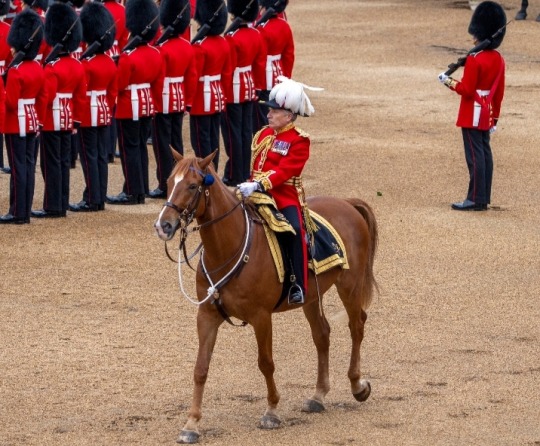
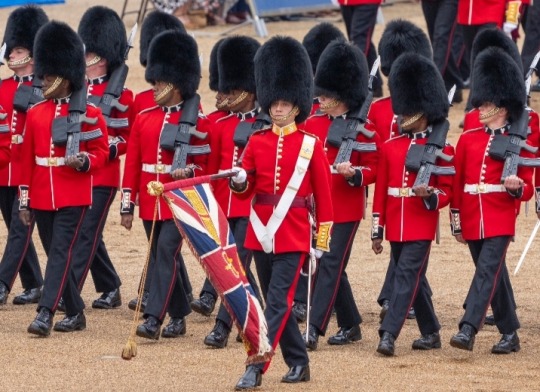

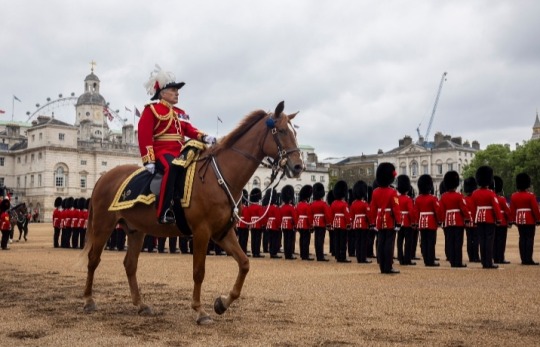
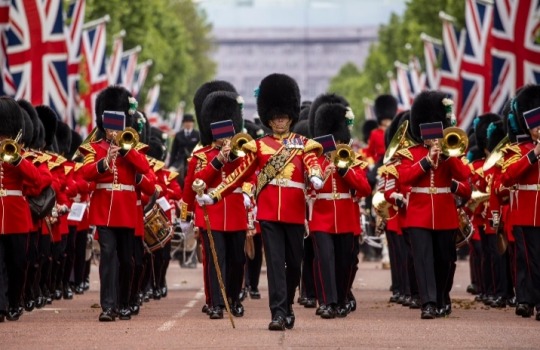
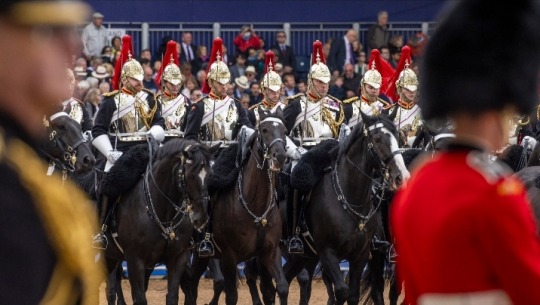
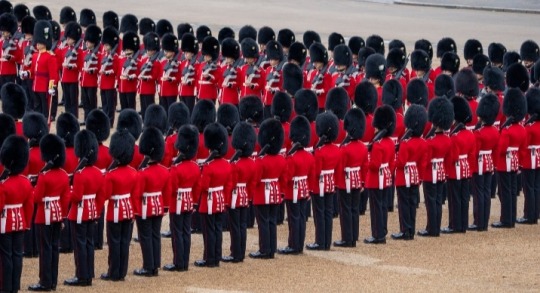
#Trooping The Colour#Trooping The Colour 2024#British Army#Irish Guards#The Major General’s Review#Horse Guards Parade#Royal Horse Artillery Guns#King Charles III#Brigade Major’s Review#public rehearsal#birthday parade#Seamus#dressing#horses#guards#soldiers#Regimental Mascot#Royal Corps of Army Music#Regimental Band of the Irish Guards
57 notes
·
View notes
Text

The King's Troop, Royal Horse Artillery Horse Guards
3 notes
·
View notes
Photo

31 May 2013 | Queen Elizabeth II smiles during a visit to The King's Troop Royal Horse Artillery unit at Woolwich Barracks in Woolwich, England. (c) Paul Grover - WPA Pool/Getty Images
11 notes
·
View notes
Text
Events 9.14 (after 1940)
1940 – Ip massacre: The Hungarian Army, supported by local Hungarians, kill 158 Romanian civilians in Ip, Sălaj, a village in Northern Transylvania, an act of ethnic cleansing.
1943 – World War II: The Wehrmacht starts a three-day retaliatory operation targeting several Greek villages in the region of Viannos, whose death toll would eventually exceed 500 persons.
1944 – World War II: Maastricht becomes the first Dutch city to be liberated by allied forces.
1948 – The Indian Army captures the city of Aurangabad as part of Operation Polo.
1954 – In a top secret nuclear test, a Soviet Tu-4 bomber drops a 40 kiloton atomic weapon just north of Totskoye village.
1958 – The first two German post-war rockets, designed by the German engineer Ernst Mohr, reach the upper atmosphere.
1960 – The Organization of Petroleum Exporting Countries (OPEC) is founded.
1960 – Congo Crisis: Mobutu Sese Seko seizes power in a military coup, suspending parliament and the constitution.
1975 – The first American saint, Elizabeth Ann Seton, is canonized by Pope Paul VI.
1979 – Afghan leader Nur Muhammad Taraki is assassinated upon the order of Hafizullah Amin, who becomes the new General Secretary of the People's Democratic Party.
1982 – President-elect of Lebanon Bachir Gemayel is assassinated.
1984 – Joe Kittinger becomes the first person to fly a gas balloon alone across the Atlantic Ocean.
1985 – Penang Bridge, the longest bridge in Malaysia, connecting the island of Penang to the mainland, opens to traffic.
1989 – The Standard Gravure shooting where Joseph T. Wesbecker, a 47-year-old pressman, killed eight people and injured 12 people at his former workplace, Standard Gravure, before committing suicide.
1992 – The Constitutional Court of Bosnia and Herzegovina declares the breakaway Croatian Republic of Herzeg-Bosnia to be illegal.
1993 – Lufthansa Flight 2904, an Airbus A320, crashes into an embankment after overshooting the runway at Okęcie International Airport (now Warsaw Chopin Airport), killing two people.
1994 – The rest of the Major League Baseball season is canceled because of a strike.
1997 – Eighty-one killed as five bogies of the Ahmedabad–Howrah Express plunge into a river in Bilaspur district of Madhya Pradesh, India.
1998 – Telecommunications companies MCI Communications and WorldCom complete their $37 billion merger to form MCI WorldCom.
1999 – Kiribati, Nauru and Tonga join the United Nations.
2000 – Microsoft releases Windows Me.
2001 – Historic National Prayer Service held at Washington National Cathedral for victims of the September 11 attacks. A similar service is held in Canada on Parliament Hill, the largest vigil ever held in the nation's capital.
2002 – Total Linhas Aéreas Flight 5561 crashes near Paranapanema, Brazil, killing both pilots on board.
2003 – In a referendum, Estonia approves joining the European Union.
2003 – Bissau-Guinean President Kumba Ialá is ousted from power in a bloodless military coup led by General Veríssimo Correia Seabra.
2007 – Financial crisis of 2007–2008: The Northern Rock bank experiences the first bank run in the United Kingdom in 150 years.
2008 – Aeroflot Flight 821, a Boeing 737-500, crashes into a section of the Trans-Siberian Railway while on approach to Perm International Airport, in Perm, Russia, killing all 88 people on board.
2015 – The first observation of gravitational waves is made, announced by the LIGO and Virgo collaborations on 11 February 2016.
2019 – Yemen's Houthi rebels claim responsibility for an attack on Saudi Arabian oil facilities.
2022 – Death of Queen Elizabeth II: The Queen's coffin is taken from Buckingham Palace, placed on a gun carriage of The King's Troop Royal Horse Artillery and moved in a procession to Westminster Hall for her lying in state over the next four days with the queue of mourners stretching for miles along the River Thames.
0 notes
Text
Timeline of Remembrance Sunday events at the Cenotaph;
• 10:58 - HM King Charles and Members of The Royal Family will leave the Foreign, Commonwealth and Development Office building and move to a position north of the Cenotaph. A full list of those laying wreaths can be found in List C on pages 16-19. Members of The Royal Family that are viewing the ceremony from the balconies in the Foreign, Commonwealth and Development Office, HM The Queen, HRH The Princess of Wales, HH The Duchess of Edinburgh, Vice Admiral Sir Tim Laurence and TRH The Duke and Duchess of Gloucester will be escorted to their rooms on the first floor.
• 11:00 - On the first stroke of eleven by Big Ben the Two Minutes' Silence commences by the firing of a gun from Horse Guards Parade by The King's Troop Royal Horse Artillery.
• 11:02 - The firing of a gun marks the end of the Silence. The Last Post is sounded by the Buglers of the Royal Marines
• 11:03 - HM King Charles lays a wreath at the Cenotaph. An equerry will lay a wreath on behalf of HM The Queen. The other members of The Royal Family will lay their wreaths as follows. HRH The Prince of Wales, HRH The Duke of Edinburgh, HRH The Princess Royal and HRH The Duke of Kent's wreath will be laid by his equerry.
Laying of Wreaths
HM The King will lay a wreath in the centre of the top step on the north side of the Cenotaph.
The following Members of The Royal Family lay wreaths in succession on the north side of the Cenotaph: -
• HM The Queen laid by Major Ollie Plunket
• HRH The Prince of Wales
• HRH The Duke of Edinburgh
• HRH The Princess Royal
• HRH The Duke of Kent laid by his Equerry Captain George Hopkins
At the Cenotaph this morning. The Princess Royal, accompanied by Vice Admiral Sir Tim Laurence, will take the salute on Horse Guards Parade for the march past of the ex-service and civilian associations following the Remembrance Sunday ceremony.
Information from @majestymagazine / Joe Little
22 notes
·
View notes
Text
5 mars 1985 Visitent la King's Troop Royal Horse Artillery à St John's Wood Ordnance Hill, dans le nord-ouest de Londres










0 notes
